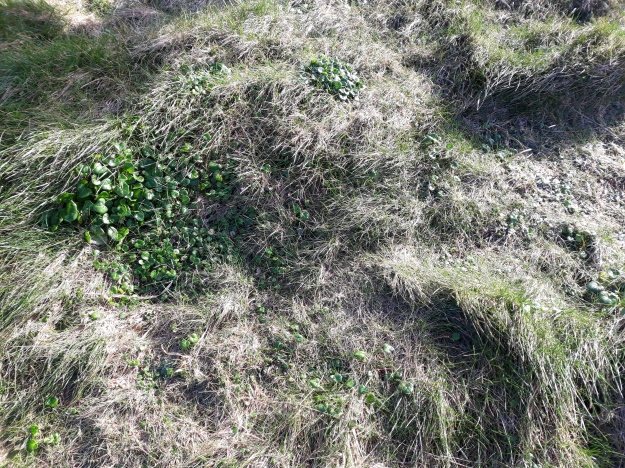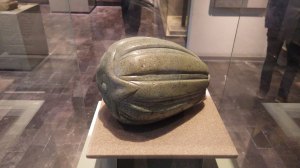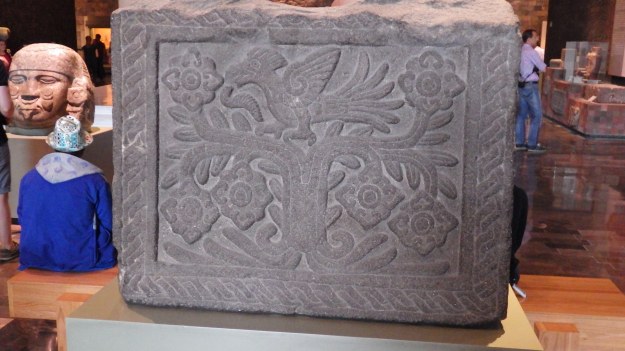UPDATE: this post is followed by an embarrassing correction. I’m leaving the original in place, unchanged, because I don’t want to hide the fact that scientists sometimes (often) make mistakes, and are as prone to over-enthusiasm and optimism as anyone else. So please read on, and don’t judge us too harshly for admitting our errors.
We have rediscovered Abies hidalgensis! This is an amazing find, and a real boost to the PinaceaeGo project. It took two solid days of hunting on inaccessible mountain slopes. To understand why this species is so important, we need to start at the beginning, with some fine detective work in the herbarium by awesome PhD student Libertad Sanchez-Presa.
Abies hidalgensis was first described in 1995 by a Hungarian botanist following a collecting expedition the previous year*. Unlike all the other ‘new’ species described in that paper, it survived subsequent critical review by Aljos Farjon, the world expert on conifers and a notorious lumper**. Libertad uncovered the type specimen in the National Herbarium of Mexico at UNAM in Mexico City. Everything about this species sounded dubious. The description of the collection locality didn’t match the co-ordinates, which were 30 km away. It was supposedly found at 2300 m altitude, whereas we haven’t seen Abies below 3000 m anywhere else in the country. Most of all, this is an arid area, and firs are usually found in dense, damp, dark forests. Nothing we saw on Google Earth suggested that such a location existed. She decided that this mysterious species was worth tracking down.

This is the duplicate specimen of Abies hidalgensis held in the Kew herbarium (obtained via HerbWeb). That label is all the information we had to go on.
Our journey began with a drive up from Puebla to Tulancingo in the state of Hidalgo, where we spent the night. An early start took us to the vicinity of Metapec, a small village to the south of the mountain range where the species was described. From there we took dirt roads as far as we could towards the location described on the sheet, though the details couldn’t be matched to the actual landscape.
For one day we hacked up and down gulleys and over ridges, sweating in the heat. We saw some amazing stuff: a huge tarantula hawk wasp killing a large spider then dragging it away; a wild Mammillaria cactus with edible fruits, which we ate; some oak ‘apples’ (really galls formed by insects) large enough to deserve the name; and an array of spectacular mushrooms. Some of our findings will be the subject of a future post.

Tarantula hawk wasp dragging its dead prey

Mammillaria sp. with edible fruits

Oak galls

I should have provided a scale here, because these mushrooms were huge.
What we didn’t see were any fir trees. More concerning was that we didn’t even see any habitat where Abies was likely to be found. There was plenty of dry pine forest and scrubland, but even scanning the slopes and plunging into the valleys revealed no firs or even evidence that they might once have been there. By late afternoon we were tired and disheartened. Had the species disappeared? Did the collector get their field notes mixed up? Was it an elaborate hoax? All sorts of explanations ran through our minds.

A dry valley. No Abies here.

Right altitude, wrong vegetation. Libertad and Sarah keep their spirits up regardless.

A patch of lichen-draped cloud forest. Nope, no Abies here either.
Typing the co-ordinates into my GPS gave a location 30 km away in the state of Veracruz. This was a long way from the site description, but it was at least up in higher mountains where Abies might more plausibly be found. There was nothing for it; we had to look. The actual driving distance was more like 50 km, ending up on dirt tracks in remote villages. All we found were large plantations of exotic trees that the locals referred to as ‘Chinese pine’ (perhaps Pinus koraiensis?). If the Abies had been there once then there was no sign of it now, nor of any native vegetation. We drove back, 100 km of wasted effort.
All the way back to Metapec we were haunted by visions of Abies in the forests around us. More than once we screeched to a halt, convinced that one or other of us had spotted something, only to discover it was just another Cupressus lusitanica.
As we drove past the ridges we had been exploring earlier in the day, it was late evening, and the setting sun was illuminating the slopes. Sarah spotted some conical trees unlike anything we had seen that day. We pulled out the telescope and peered through the dusty haze. There was definitely something up there, tucked away in an inaccessible valley… but we had become rather jaded by our earlier experiences and were no longer willing to trust our eyes. Besides, it was 10 km away, and there was no hope of making it up that evening.
The next day we had plans to inspect another site, but made the difficult decision to try again, one last time. If it was there then it would be remarkable; if not then we were all ready to remove it from our biogeographical analyses as an aberration. We started out from a different point, navigating through the slopes towards the valley Sarah had identified from the road.
Emerging onto a ridge crest, it was Sarah who again noticed something unusual. On the next ridge north of us, atop an escarpment a few hundred metres away, a small tree was poking up with a distinctive conical form. It was only around two metres tall and, squinting through the telescope, it looked like it just might be an Abies. Reaching it would be extremely dangerous though. We pressed on.
We climbed further up until we reached a high ridge at 2600 m close to our target location. It was lunchtime and we were tired and hungry. We dropped bags and looked around the typical oak-alder forest. Libertad pointed towards something growing in the understorey. Could it be?

Sarah celebrates finding the first Abies seedling. It’s just to the right of her.
She ran over and confirmed — we had an Abies! In fact, they were all around us. But at this altitude, in this vegetation, was extremely peculiar. It wasn’t anything like the normal conditions for Abies, nor in fact much like the site description from the herbarium records. None of this made much sense. As we descended down the opposite, north-facing side of the ridge, they were everywhere. The tallest individuals exceeded 20 m in height and 50 cm in diameter, with a range of sizes and plentiful seedlings. But they were growing in dry, open conditions, on a ridge with cacti nearby; how was this possible?
We only had a few hours before we needed to return home. In that time we managed to collect herbarium specimens, tissue samples in alcohol for genetic analyses, trait data for our own work and core two large stems***. The steepness of the slopes, peppered with escarpments, made it impossible to descend far into the valley below, but we could see more Abies down there and on the opposite slope. Talking to a local farmer later that evening it sounds as though another route into the valley exists, which we may explore next time. We left as late as was safe, exhilarated and exhausted, and also a little frustrated at not being able to stay longer and collect more data.

Two large, healthy specimens of Abies hidalgensis, right on an exposed ridge top. This is not where we would have expected to find them.
What now? We have the trait data we were looking for, and can confirm not only the presence of this species but also its exact location. Our samples will be sent to local herbariums and experts; hopefully the tissue samples will allow a systematist to determine the true place of this species on a phylogeny and identify its nearest relatives. We are also a little puzzled by the cones, which don’t look much like those on the existing herbarium specimens.
That’s not where this story should end though. The species is listed as vulnerable on the IUCN Red List, which is reasonable given that the range of this population can be no more than two square kilometres. One hot summer and a severe forest fire could severely deplete its numbers, a disaster which becomes increasingly likely in a warming climate. Having found the species again, we now bear some responsibility to do something about it.

So far as we know, these two valleys encompass the global range of Abies hidalgensis. Rumour has it that there are some more close to the village of Agua Blanca to the north, but we were unable to confirm this.
What this action should be is something we will need to discuss. Perhaps we could undertake a comprehensive mapping exercise and population estimate; press for the designation of a protected area; collect seeds or propagate live material for ex situ conservation; set up a mapped forest dynamics plot… all could be the subject of future work.
Personally, I think the most important outcome should be a local education campaign. We spoke to many locals and farmers over the course of the two days, yet only one knew about the species. These are people for whom this forest is on their doorstep, who use it to hunt or collect firewood and mushrooms. Realising that their forest contains a tree of global importance and interest should be a matter of great pride, and will be the key to ensuring that it remains well protected.

Libertad’s plant press contains that most precious of cargoes: herbarium specimens of Abies hidalgensis, the first to be collected for over 20 years, linked to a much greater amount of contextual information and data on the individual trees.
* Their visit is described briefly in this paper. They didn’t manage to see a great deal on their two trips up the mountain.
** Taxonomists are often broadly stereotyped as ‘splitters’ or ‘lumpers’. Splitters have a propensity to declare new species on the basis of fine differences among populations, sometimes as much through wishful thinking as meaningful variation. Lumpers review these designations and collapse them into single species. Splitters don’t like lumpers because they take ‘their’ species away. This tension has been present throughout the history of taxonomy.
*** Coring carries a small risk to the tree, and therefore should only be performed with a good reason and where you can be confident that there are plenty of individuals. From these cores we can determine the growth rates of the trees and look for any indication of climate dependence or changes over time.
IMPORTANT UPDATE (18 August 2016)
Well, as the new header on this post might have given away, we didn’t actually find Abies hidalgensis. We had grown increasingly suspicious of our collection over the days that followed, and on depositing the specimens in the herbarium at Monterrey, our fears were confirmed. We had actually collected Pseudotsuga menziesii.
How did three experienced plant ecologists come to make such a big mistake? There are a few mitigating factors. Psuedotsuga wasn’t previously recorded in this area, so we weren’t expecting to see it. We were tired, clutching at straws, and perhaps too ready to leap at anything that looked like an Abies. Finally, they aren’t that easy to tell apart. I should be embarrassed because I know Pseudotsuga menziesii well from North America (its common name is Douglas fir), but the local Mexican type actually looks very different, and some botanists have tried to designate it as a different species. I won’t comment on this other than to say that the accepted approach is to consider it as a single species with sub-specific variants and a high degree of morphological variation.
Where does this leave Abies hidalgensis? We still don’t know. The original collection records for the type specimens are contradictory and bear little resemblance to the landscape of the area. We tried everywhere that sounded roughly right, or that looked like it might be Abies habitat, and a lot of places that weren’t, just in case. We did everything we could to find this species in the time available and failed. Is it actually there at all? Was it ever? We are back to having some serious doubts about the very existence of this species.
As for our error, it’s an excellent demonstration of why scientists publish in journals rather than online blogs. When we submit a paper, as we would eventually have done, our findings go through many layers of careful scrutiny. It takes a long time, and many ideas fall by the wayside in the process. It’s easy to dash off a small blog post in the evening with a beer and claim quick credit, but were these to be treated as findings equivalent to published articles, it would carry the risk of mistakes ending up in the body of scientific knowledge. So you should never automatically trust a blog post, press release or similar non-standard means of transmitting a scientific finding. It may get more attention than a paper published years later, but it carries a high risk of being wrong, as we were.
Still, we had fun :o)











 To finish off the cacti, how about this metre-tall carved columnar cactus, probably from the genus Cereus? I definitely coveted this for a corner of my living room. It’s thought to be a boundary marker between two territories, and has the face of a legendary Mexica leader carved into its base. What interests me is that this kind of cactus isn’t present in that area, at least not in the modern world. Was it chosen because it was a feature of the landscape back then, or alternatively because it would stand out as unusual?
To finish off the cacti, how about this metre-tall carved columnar cactus, probably from the genus Cereus? I definitely coveted this for a corner of my living room. It’s thought to be a boundary marker between two territories, and has the face of a legendary Mexica leader carved into its base. What interests me is that this kind of cactus isn’t present in that area, at least not in the modern world. Was it chosen because it was a feature of the landscape back then, or alternatively because it would stand out as unusual? Another impressive piece of Mexica sculpture was this calabaza (Cucurbita moschata), a relative of the modern pumpkin. This magnificent piece was the size of… well, a ripe pumpkin. Alongside maize, which appeared in countless exhibits, beans and chilli, this was one of the staple foods of the peoples of central Mexico.
Another impressive piece of Mexica sculpture was this calabaza (Cucurbita moschata), a relative of the modern pumpkin. This magnificent piece was the size of… well, a ripe pumpkin. Alongside maize, which appeared in countless exhibits, beans and chilli, this was one of the staple foods of the peoples of central Mexico.



























